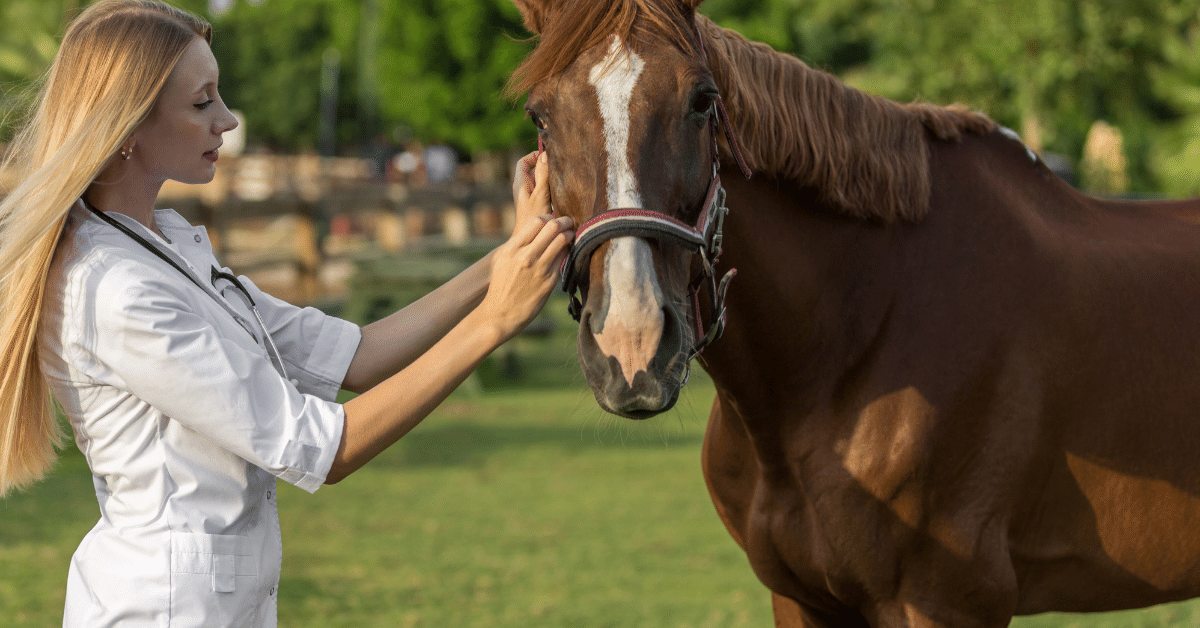Since purchasing a horse can be a large financial investment—both the purchase price itself, as well as any medical bills that arise later due to health or lameness issues—it makes sense for horse owners to do their research prior to buying a new horse.
As such, a pre-purchase examination with a veterinarian is typically performed prior to the sale going through, which includes a physical evaluation and possibly radiographs.
What Is Included In a Pre-Purchase Examination of a Horse?
At the very least, a pre-purchase check includes the horse’s history (ownership, work, and medical history) and a full physical evaluation.
A horse’s identification should be verified. A vet may also make notes about the horse’s temperament or other non-medical factors.
The horse’s history is important when considering expectations of future performance.
For example, what is the horse being purchased for, i.e., what will their job be? And how does this level of activity compare to their current level of activity?
Then there’s a standard full physical examination, which looks for abnormalities of the skin, eyes, mouth, cardiovascular, gut, and other body systems.
This includes evaluating the horse before and after physical exertion and seeing how long it takes them to recover.
The musculoskeletal part of the exam may include more detail while evaluating for lameness. Examples of this part of the exam include (but are not limited to)...
Observing the horse’s gait at walk, trot, canter, or other tasks, both saddled and unsaddled.
Palpation of the limbs, neck, and back.
Hoof evaluation and hoof testers.
Flexion testing.
Range of motion.
In addition to the physical examination and lameness evaluation, diagnostic testing may be performed. This might include…
Bloodwork or labs for general health.
Drug testing.
Diagnostic imaging, including radiographs of the joints or ultrasound of tendons.
Any additional tests (breeding soundness, tests required for interstate travel, endoscopy for respiratory issues, etc.) as needed.
Which Radiographic Views Should Be Included In a Horse Pre-Purchase Exam?
That being said, there is some debate over which/how many views should be included.
When in doubt, it’s probably best to err on the side of caution and obtain more views rather than less, since these views may potentially be used in litigation if the buyer ends up encountering a problem with the horse.
For this reason, the images also need to be of excellent quality, and it is recommended to use standard views/angles.
Radiographs of the limbs may include views of joints and bones that are more likely to encounter issues, especially the…
Stifles (craniocaudal, lateral, +/- obliques).
Hocks (DP, lateral, +/- obliques).
Fetlocks (DP, lateral, +/- obliques)
Foot/navicular series.
Additional views could be added depending on the needs of the situation. This may include additional joints, additional angles or flexed/stressed shots, or even vertebral studies of the neck and back.
A veterinarian would be looking for any abnormalities, such as previous or current injuries, arthritis, or OCD lesions. Of course, all of these findings should be correlated with the horse’s history and clinical evaluation.
Getting a radiologist consultation on pre-purchase radiographs is never a bad idea either.
Conclusions from a Pre-Purchase Examination
The purpose of a pre-purpose examination, including the radiographs, is to uncover any abnormalities which may potentially lead to a problem later, so a buyer has more information about what to expect from that particular horse.
However, it’s important to remember that there aren’t a lot of “perfect” horses out there. Most horses will have some type of lesion or abnormality uncovered.
While some abnormalities may predict a severe issue and lead to cancellation of the sale, other potential issues are not so clearcut. A pre-purchase examination isn’t a guarantee that a horse will never have a problem. And a mild abnormality may be perfectly acceptable to the buyer for the purpose for which they are purchasing the horse.
The goal is to provide information, and to convey that information to the buyer so they can make an informed decision and get the horse that’s right for them.
Written by: Dr. Tammy Powell, DVM



